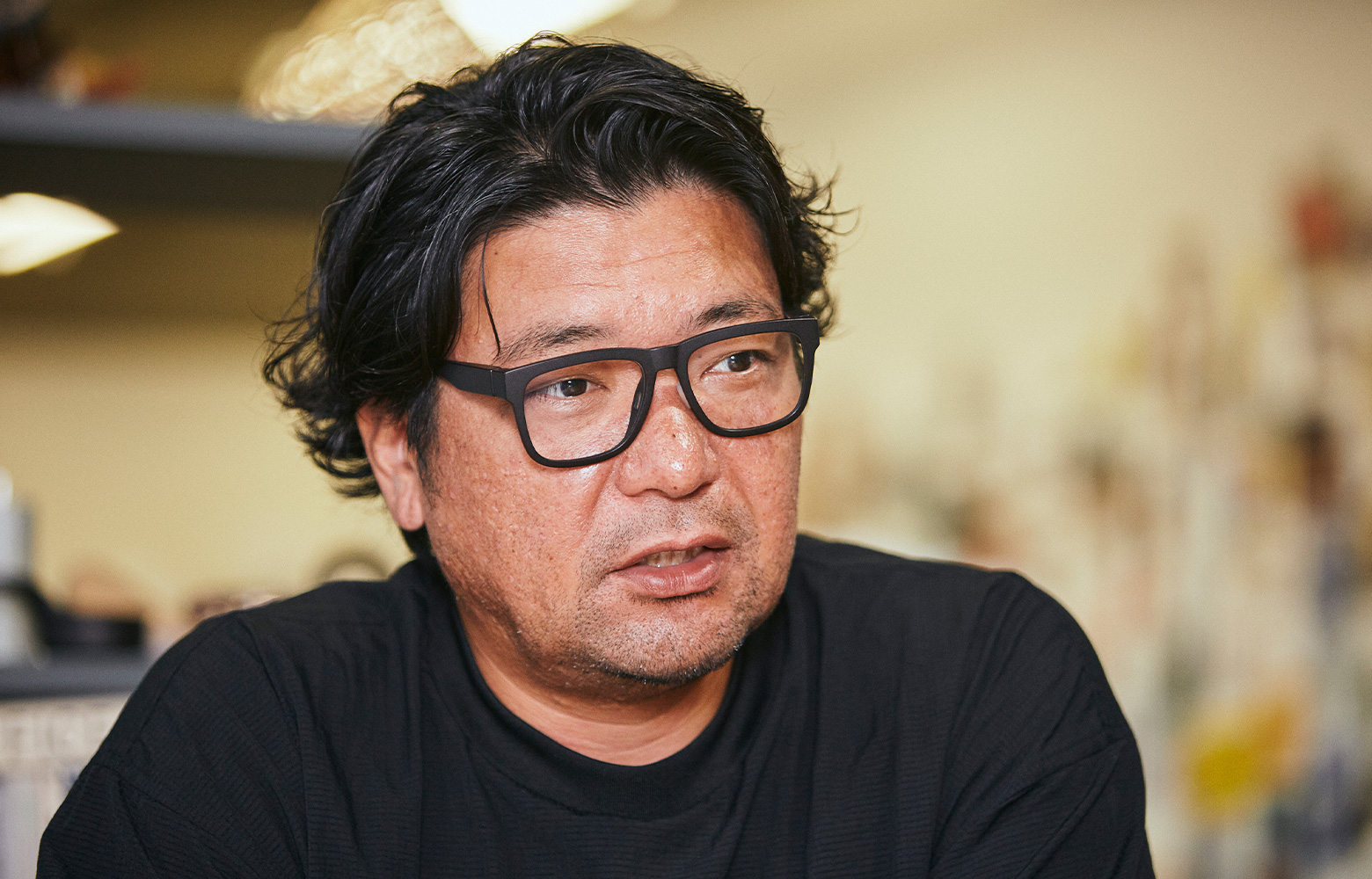From product design to interior and space designs, Jin Kuramoto is involved in design projects of all genres. We asked him to describe his everyday thoughts on design and the air that surrounds it.
Encounter with Design
My first encounter with design was in university. More than thinking about design theory, I worked at a frantic pace to finish assignments while studying the basic techniques. However, because I enjoyed it, I don’t recall it being especially grueling. Instead, I felt grateful for the opportunity to pursue design as a profession.
My first job was designing a mobile phone. As always, I thought how lucky I was to be making a living doing something that I loved, but after about two years, I gradually began thinking about the depth of design. Designing for a company means continuing to express the value and purpose of the company through design. Once I became conscious of this, I couldn’t help but notice a significant gap between my own individual stance and that of the company.

As a result, I began agonizing over who the designs were for. I felt that I should express what I felt and began working freelance. I started with projects in the interior design field while working at the same time in product design at the company. However, working at the company as my main work kept me from devoting myself to my personal projects except during my free time and on weekends. Because there are limits to what you can focus on, I felt that I had no choice but to break away, so I became self-employed at the age of 31 years old. Currently, about half of my work relates to interior design, such as furniture, with the other half relating to corporate consulting, branding, and product development in consumer electronics. For this reason, I now feel that my experiences and the people whom I encountered in working as an in-house designer were extremely important.
Prerequisites for Design
I always keep two main things in mind when I am designing. The first is communication. For example, the designer is asked to "make something like this" in a project after the content of the request has been fixed to some extent. Consequently, I try to get as much information as possible by talking to the people involved, including management and the people in charge of development and sales, so that I can fully understand the project background. To me, it feels more comfortable to use design as an expression of the input that you have received.
Where does the company want to go, and what are the people involved thinking? Having communication skills is important to absorb information that is not being presented at face value since you must always be careful not to misrepresent the direction of the brand or what the company aspires to be. If communication is input, then design is output, and maintaining a sense of balance for both is key. I believe that my encounters with other people have led me to where I am now and given me a strong sense of conviction that is inclined to say, "Let's give it a try!"
The second has to be materials. First off, you can’t create anything without materials. This is especially true for product design where value and functions, whether they be for furniture or consumer electronics, are a part of a design that is established by direct contact with the users. So, how do you decide on materials such as wood, plastic, and glass and how they blend with the surrounding air? Instead of relying on your ego for making changes in materials and colors, you listen to what the materials themselves are telling you to do and focus on where those voices are guiding you in terms of structure and exterior design.

Coat rack called Knit designed for HAY in Denmark.
Enlarging the Areas of Design
In the past, someone who saw my work once characterized it as having “dignified tension.” Certainly, there is a sense of tension and austerity, and those are important aspects of expression, but those qualities alone would make it difficult to harmonize with the lives of the people who use the product. For this reason, I am conscious of coexistence and strive to also create an impression of familiarity and reliability along with gentle ambiance. While giving space a sense of presence, designs should also blend in with their surrounding and generate a good vibe. That is the sort of thing that I want to make.
The most interesting thing about designing furniture is not only the furniture itself, but also the sensation of thinking about the air around it in a radius of about 5 meters. While it is necessary to verify the design appearance and product functionality to make sure it is beautiful and easy to use, it is sometimes impossible to know whether it will fit in with the space until you spend time with it. With that in mind, I sometimes put it in my office or home for a period of time to evaluate the design. You can't decide whether it is good or bad just by looking at it on its own. You have to look at it as an image that designs the surrounding air.

ACTUS, CondeHouse, KOKUYO, and our company developed a desk chair called FOUR.

This is a pitcher called vannfall designed for Nedre Foss in Norway.
For example, when designing a single cup, you must ask yourself questions: What kind of table will it be placed on? What color are the walls around it? Who is in the room? What size is the building? What role does the building play in the city? Clearly, the areas that we must be conscious of are expanding endlessly.
I first became interested in this sort of topic when I was an in-house designer. That was a time for me to expand the areas for forming a design vision from small things to big things and for that you have to tilt your antenna to the spatial relevance of various events. It is necessary to be aware of the spatial axis and the time axis in a complex manner. In the end, I’ve returned to the act of redesigning the small products that were in front of me. Nowadays I feel that the things I struggled with when I was young are being used in my current space designs, installations, and exhibition hall designs.
Achieving the Sustainability Demanded of Designers
While Japanese companies have finally begun to diligently confront sustainability, sustainability and circularity of the global environment have been serious considerations in projects with overseas companies for many years now. Unsurprisingly, movements have been affecting the work of designers since the birth of design arose in the background of industrial revolution. Prior to that, the world revolved around small-scale “craft” production, which can be thought of as crafts and folk crafts, but oil production brought about a drastic change to the industrial structure and led us to a situation in which the crassness of mass production began debilitating society. William Morris, the "Father of Design," recognized this and started activities that became the catalyst for the birth of design. From this, the Bauhaus school that advocated functionalism was established in Germany, and the base of modern design was created by people who would later be called designers. Their mission was to do something about a world overflowing with things.

In this way, social trends can help shape the designer’s mission. The mission given to designers in this era is how we can contribute to the realization of a recycling society. Companies and brands that fail to take action will not survive in the future. This is a theme for which all of us involved in economic activities must think about. Also, it should be the designer's job to be able to project a vision to get there. For example, questioning the value of growth as expressed in the index of GDP may be one idea that could contribute to the environment. The general understanding is that lower volume of consumption and production is undesirable and leads to a decline in incomes and economic slowdowns. But if we were to present new indicators and values of affluence then lower levels of production and consumption might be seen as something positive. One solution might be relinquishing economic advances to recapture what has disappeared in a capitalist society. I would like to tackle better approaches and ideas for cohabiting with the natural environment and other living beings.













